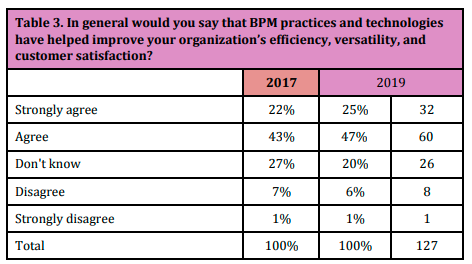If you’re looking to improve your organization’s productivity, business process improvement (BPI) is an effective option. BPI helps you improve workflows, so processes are more efficient, re sponsibilities are better defined, and employees understand their role in the bigger picture.
In this article, we’ll discuss ways to improve productivity with BPI and how you can make the most of a process-efficient system.
🎓 CAFLOU® academy is brought to you by CAFLOU® - 100% digital business management software
When should you consider business process improvement?
The short answer is: when your organization starts suffering from workflow inefficiencies.
These inefficiencies typically arise – and grow – as your business scales. When organizations scale, they have to manage:
- More customers/accounts. This can increase the complexity of interactions. For example, if a customer engages with two different support agents – each agent needs to know the other’s interaction.
- More employees. More employees mean larger teams with more complex workflows – so each team member needs to clearly understand their responsibilities, and your expectations of them.
So, managers and team members may experience workflow challenges as you scale. Some symptoms of these challenges include:
- Project leaders struggle with managing projects. They don’t know the real progress or status of the project, and employees aren’t clear on their responsibilities.
- Customer experience starts to suffer. Your customers aren’t happy with the results, or they’re getting their deliverables late.
- Inconsistent output is a common occurrence. Team leads and managers clearly communicate the project’s requirements, but the results are inconsistent and not suitable for delivery.
These symptoms indicate that your business needs to consider process improvement.

What are the benefits of implementing business process improvement?
Business process improvement (BPI) is used to increase the efficiency and effectiveness of your processes. So, the typical BPI journey includes discovering and mapping your business processes, addressing bottlenecks, and continuously analyzing and optimizing existing systems.
Here are 5 benefits of implementing BPI.
1. Greater productivity
Process improvement is a management practice, process in its own – not a software or tool – so it’s versatile and tailored to your organization’s needs. You can analyze and map existing processes to discover – and eliminate – unnecessary or laborious processes.
By minimizing inefficiencies, your team members can focus on high-impact work and deliver better results.
2. Less errors and risk
When workflows and responsibilities are clearly defined, managers can quickly identify weaknesses and engage the right team members if specific problems arise. Moreover, BPI helps you achieve more consistent outputs – reducing the risk. E.g. Account managers can worry less about receiving an incomplete client proposal at the eleventh hour.
3. Higher employee satisfaction
When business processes are optimized, your employees spend less time on mundane tasks and fixing problems – and more time on meaningful, high-impact work.
4. Greater customer satisfaction
According to the State of Business Process Management 2020 report, 72% of surveyed businesses agreed or strongly agreed that business process management encouraged improvement in their organizations - including an increase in customer satisfaction:

Source: State of BPM 2020 Report
5. Speed and flexibility
When business processes are clearly defined, scaling up or down becomes easier. You can duplicate repeatable processes to manage new customers and accounts, or remove stages from a more detailed process if the need arises.
What are the challenges in implementing business process improvement?
While BPI has great potential to improve employee productivity, there are some challenges that can make it difficult to implement. Here are three of the most pressing ones.
1. Unclear goals and objectives
As we discussed earlier, process improvement should help you streamline workflows and achieve meaningful results. For example, your BPI implementation should achieve at least some of the following results:
- Improved customer satisfaction/experience
- Heightened employee morale and productivity
- Faster delivery times
- Easier scalability
But if you’re uncertain about your business goals, designing a plan for process improvement becomes difficult. You won’t know which processes to prioritize and where to tailor your efforts.
2. The wrong attitude towards BPI/BPM
Business process improvement/management exists to help you achieve business goals. However, focusing on business management software as means to BPI implementation – while sidelining its purpose – can hurt performance. Business software exists to help you reach your goals, not to define them.
BP Trends’ report highlights the gap between business goals and process improvement initiatives – the research revealed that many teams could not deliver ROI estimates requested by senior management.
3. Internal skills gap
Another pressing challenge in BPI comes from a skills shortage; many businesses lack the in-house expertise to effectively implement process management and improvement. In 2019, 23% of companies surveyed by BP Trends reported that previous business process initiatives had failed within their organization.
How to increase productivity with business process improvement
Here are six steps to improve your organization’s productivity with BPI.
1. Define your process improvement plan
As we mentioned earlier, specific signals will alert you to the need for BPI implementation. Your team might discover processes that can be made more efficient, automated, or eliminated altogether.
So before you move forward with process improvement, it’s important to outline a clear plan for change. What are your goals? What tools and systems do you intend to use? And what business goals are you trying to achieve?
2. Map out business processes
At a glance, business processes may seem overly complex and non-repeatable. But when you’re considering process improvement, it’s important to challenge these impressions. And mapping out each process can help you out here.
When you map out business processes, scrutinize each stage and look for inefficiencies. Get team leads involved and ask them to identify where problems arise. You can then zero in on inefficiencies, and automate repetitive tasks.
Although some processes may not be entirely automatable, using automation for specific stages can still save considerable resources and improve efficiency.
3. Analyze formal processes to identify failures
Many businesses have formal processes – with set procedures, documentation, and established steps. When you’re mapping business processes, don’t forget to audit these existing formal ones. You might discover inefficiencies and room for improvement.
An example of a formal process can be submitting client invoices or managing sensitive client information. These processes may have set steps already, but you can explore practices to improve efficiency, and reduce errors and redundancies. For example, business process automation can invoice clients at specified intervals and process internal claims.
4. Get senior management and your team on board
According to the State of BPM 2022 report, many businesses struggle to move forward with process improvement because they lack top management buy-ins. Senior management may question the ROI of BPI initiatives, or doubt their effectiveness. However, their approval is necessary to move forward with BPI implementation.
So, it’s important to tie your BPI plans to revenue and tangible results. For example, calculate the manhours saved for a given job if it were to be automated, or the cost savings for reducing errors in a certain task by X%.
5. Implement BPI techniques
Process improvement is not restricted to one approach. You can come up with your own process or there are several proven methodologies you can leverage to drive BPI initiatives, if needed. For example, some popular strategies are:
- The Lean Thinking methodology. In this approach, teams eliminate any processes that don’t deliver value – minimizing waste. You can apply the Lean Thinking approach to remove unnecessary tasks after mapping out business processes.
- Total Quality Management (TQM). This strategy is best for customer-centric companies, because it prioritizes customer satisfaction as the end goal. TQM encourages teams to make data-driven decisions that deliver real value to customers.
- Six Sigma. While the Lean Thinking approach prioritizes waste reduction, Six Sigma focuses on improving process quality. The Six Sigma methodology is typically used by teams that have a direct effect on a company’s bottom line.
So if your business is ready to implement BPI, it’s important to consider what your process will look like, research different methodologies and choose one (or multiple) that best aligns with your business goals and structure.
6. Leverage business process automation
If you have business processes that are:
- Repetitive
- Rules-based (i.e. they have set, defined steps)
- Labour-exhaustive (i.e. they take up a lot of your team’s time)
Then these processes may be strong candidates for automation. Automation tools can help you streamline manual tasks, reduce costs, improve efficiency, and make better decisions. They also provide more accurate data and greater visibility into operations.
According to Salesforce’s 2021 global survey on Trends in Workflow Automation, nearly 75% of technical leaders have observed time savings equivalent to at least four hours per 40-hour week after implementing automation.
You can learn more about business process automation in our guide for small businesses.
7. Prioritize continuous improvement
Process improvement initiatives can take time to deliver the results you anticipated, and some ventures may fail entirely. Thus, it’s important to monitor progress (and failures) with a continuous feedback loop, and intervene when necessary.
You can track KPIs relevant to your BPI initiatives – such as reduction in manhours, percentage of improved accuracy, or cost reduction – to track and measure the success of different ventures. And when problems arise, it’s important to investigate each process to determine possible root causes - some initiatives may fail because of nuances in their execution. The initiative may still be viable, with some tweaks.
Streamline your business process improvement with CAFLOU
CAFLOU is an integrated business management suite that helps small businesses improve productivity with business process improvement. With CAFLOU, you can
Automate with ease
CAFLOU’s own workflow engine lets you automate manual activities or set up rules that create actions. You can also use CAFLOU to automate reporting or recurring objects feature that lets you automatically create business objects – such as tasks, projects, invoices, or expenses – at a specified frequency.
Manage your important processes in one place
Manage your company’s internal workflow, sales cycle, project, task and time management or business economics in one centralized platform.
Track productivity and performance
CAFLOU not only lets you monitor business or project performance, but also employee performance. Track and measure which teams – or team members – are generating the most revenue for your business, using CAFLOU’s economics reporting.
Start improving your business processes with CAFLOU for free.
<< Back to all articles in Caflou Business Management Academy